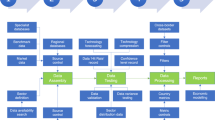Abstract
The effects of production and consumption in the informal sectors, i.e., the black sector (illegal because of tax evasion) and the green (household) sector, are described by a macro model. Effects upon employment, balance of payments, and public deficit are considered. Empirical implementation with Danish data shows that the black and green sectors have negligible effects on the government deficit, and that activities in the green sector are much more harmful to white employment and the balance of payments than are activities in the black sector. The results indicate that formal and informal production of services — the major part of the black and green sectors — could be increased without much damage to the balance of payments and the government deficit. Whether such an increase of service production would also solve the social problems related to unemployment is more debatable, since many service jobs are likely to be considered by the public as unproductive uses of labour.
Zusammenfassung
Die Auswirkungen von Produktion und Verbrauch im informellen Sektor, also im schwarzen Sektor (Schattenwirtschaft, die wegen Steuerhinterziehung illegal ist) und im grünen Sektor (private Haushalte) werden anhand eines Makromodells beschrieben. Die Wirkungen auf die Beschäftigung, auf das Zahlungsbilanzgleichgewicht und auf die Staatsverschuldung stehen dabei im Mittelpunkt. Die empirische Analyse anhand dänischer Daten macht deutlich, daß der schwarze und der grüne Sektor zu vernachlässigende Auswirkungen auf das Haushaltsdefizit haben, sowie, daß Aktivitäten des grünen Sektors der Vollbeschäftigung und dem Zahlungsbilanzgleichgewicht im weißen Sektor weitaus mehr schaden als Aktivitäten des schwarzen Sektors.
Die Ergebnisse zeigen, daß die formelle und informelle Produktion von Dienstleistungen — Hauptbestandteil des schwarzen und grünen Sektors — ohne größeren Schaden für die Zahlungsbilanz und für das Haushaltsdefizit ausgeweitet werden könnten. Ob ein derartiger Anstieg der Dienstleistungsproduktion die mit der Arbeitslosigkeit verbundenen sozialen Probleme lösen könnte, ist fraglich. Denn die Öffentlichkeit neigt dazu, viele Dienstleistungen als unproduktive Verwendung von Arbeitskraft anzusehen.
Similar content being viewed by others
References
Aage, H. (1976). Beskæftigelses- og betalingsbalancevirkninger af at erstatte offentligt forbrug med privat (Employment and balance of payment effects of substituting private consumption for public consumption). Juristen & Økonomen, 58, 385–401.
Aage, H. (1981). Devaluation and exporters' price reactions: A theoretical model for the Danish economy with numerical illustrations. Paper presented at the Econometric Society European Meeting, Amsterdam, September.
Aage, H. (1988). Consumption, income distribution and incentives. In: R. Weichhardt (Ed.), The Soviet economy: A new course?, pp. 47–70. Brussels: NATO Economics Directorate.
Blades, D. (1982). The hidden economy and the national accounts. In: OECD Economic Outlook, Occasional Studies June 1982, pp. 28–45. Paris: OECD.
Bonke, J. (1983). Aldrig mere arbejde — Økonomi og virkelighea (No more labour — Economics and reality). Copenhagen: Rosinante.
Dahlgaard, F. (1983). Den sorte økonomi (The black economy). Samfundsøkonomen, 1(2), 8–17.
DØR, Det Økonomiske Råds Sekretariat (1983). Dansk økonomi maj 1983 (The Danish economy, May 1983). Copenhagen: Direktoratet for Statens Indkøb.
Gabor, I. R. (1979). The second (secondary) economy: Earnings activity and regrouping of income outside the socially organized production and distribution. Acta Oeconomica, 22, 291–311.
Gershuny, J. (1983). Social innovation and the division of labour. Oxford: Oxford University Press.
Grossman, G. (1982). The second economy of the USSR. In: V. Tanzi (Ed.), The underground economy in the United States and abroad, pp. 245–269. Lexington, MA: Lexington Books.
Gundersen, J. (1982). Uformel økonomi — med særligt henblik på att belyse omfanget (The informal economy — with special reference to its size). Copenhagen: University of Copenhagen, Institute of Economics. Unpublished Thesis No. VI 511.
Hawrylyshin, O. (1976). The value of household services: A survey of empirical estimates. Review of Income and Wealth, 22, 101–131.
Isachsen, A. J., & Strøm, S. (1981). Skattefritt. Svart sektor i vekst (Tax-free. The growing black sector). Oslo: Universitetsforlaget.
Kendrick, J. W. (1979). Expanding imputed values in the national income and product accounts. Review of Income and Wealth, 25, 349–363.
Kenedi, J. (1981). Do it yourself. Hungary's hidden economy. London: Pluto Press.
Marx, K., & Engels, F. (1961–1969). Werke. Berlin: Dietz.
Mogensen, G. V. (1985). Sort arbejde i Danmark (Black labour in Denmark). Copenhagen: Nyt Nordisk Forlag Arnold Busck.
Murphy, M. (1982). Comparative estimates of the value of household work in the United States for 1976. Review of Income and Wealth, 28, 29–43.
Observa (1981). Danskerne 1977–1980 (The Danes 1977–1980). Copenhagen: Observa.
Statistisk tiårsoversigt 1983 (Statistical 10 year survey) (1983). Copenhagen: Danmarks Statistik.
Stetkaer, K. (1983). Den sorte i nationalregnskabssammenhæng (The black sector and the national account). Samfundsøkonomen, 1(2), 18–24.
Thage, B., & Folke, T. (1982). Import- beskæftigelses-og energimultiplikatorer 1979 (Import, employment, and energy multipliers 1979). Nationalregnskabsnotat No. 6. Copenhagen: Danmarks Statistik.
Additional information
Hans Aage is an associate professor at the Institute of Economics, University of Copenhagen, Studiestræde 6, DK-1455 Copenhagen K, Denmark.
Rights and permissions
About this article
Cite this article
Aage, H. White, black, and green multipliers: Effects of white, black, and green sector activities on the economy and on the development of consumer services. J Consum Policy 12, 39–57 (1989). https://doi.org/10.1007/BF00411388
Issue Date:
DOI: https://doi.org/10.1007/BF00411388




